Physical Science Chapter 19
19-1 Electric Charge
 |
• |
An Atom consists of protons, neutrons, and electrons. |
 |
• |
Protons and electrons have a basic property called "charge." |
 |
• |
Charge affects the behavior of particles. |
 |
• |
Protons are positive "+" |
 |
• |
Electrons are negative "-" |
 |
• |
When protons and electrons are not evenly matched in an atom - a charge results. |
Opposite charges attract. +-
Like charges repel. + repel + : - repel -
 |
• |
Lines of force called an "electric field" surround charged particles. (p484) |
19-2 Static Electricity
 |
• |
An object acquires an electrical charge when it gains or loses electrons. |
(gain electrons - "negative"; lose - "positive")
 |
• |
An object can become charged by |
friction:
conduction:
Conductors allow the flow of charges.
Insulators do not.
induction:
 |
• |
Static electricity is the buildup of electric charges on an object.(TV, Carpet,animals) |
 |
• |
A loss of static electricity is called an electric discharge. (Lightning 100 million volts) |
 |
• |
An "electroscope" can detect an electric charge. |
19-3 The Flow of Electricity
 |
• |
Differences in potential energy cause electrons to flow. |
 |
• |
Potential difference (called voltage) is measured in volts (V) by a voltmeter. |
 |
• |
Battery: Dry cell or wet cell. Converts Chemical energy into electrical energy. |
 |
• |
Thermocouple: Converts heat energy into electrical energy. |
 |
• |
Photocell: Converts sunlight into electrical current. |
 |
• |
Circuit: A closed path through which electrons can flow. |
 |
• |
Current: Flow of electrons. Flows across metal wire or another conducting material. |
 |
A means of maintaining potential difference is necessary in order for current to flow. |
 |
• |
Current flow is measured in amperes (A). |
 |
• |
Resistance: Opposition to the flow of electrons. |
 |
Resistance is measured in ohms ( ). |
 |
• |
Superconductors: Materials that have no electrical resistance - "current can flow without losing energy." |
 |
• |
Super conductors tend to be brittle and require extremely cold temperatures which currently make them impractical for widespread commercial use. |
 |
• |
Ohms Law: Current in a metal conductor is |
directly proportional to the potential difference across its ends and
inversely proportional to the resistance.
 |
• |
Potential Difference = current x resistance |
 |
• |
Voltmeter: Measures electrical potential. |
(In volts) unit volts variable V
 |
• |
Ammeter: Measures current flow. (In amperes) unit A variable is I |
 |
• |
Ohmmeter: Measures electrical resistance. (In ohms) _______depends on the material (the larger the wire the less the resistance the long the wire the more the resistance) |
V (volts) = I (amperes) x R (ohms)
 |
• |
Direct Current: Electrons flow in only one direction - battery / generator. |
 |
• |
Alternating Current: Electrons flow back and forth - reversing their direction regularly - alternator. |
 |
• |
Electric currents is the rate that electrons pass a given point in a given time |
 |
• |
Series circuit: A circuit in which there is only 1 path for the current to follow. |
 |
• |
Open Circuit: Current stops when any part of the circuit is open. (Broken link) |
 |
• |
Closed circuit: The switch is open and the path is not complete |
 |
• |
Parallel circuit: Separate paths for current to travel. |
(Circuit diagram symbols.)
 |
• |
Circuit Breakers or Fuses are used as safety devices to prevent excessive current flow which could cause a fire. |
 |
• |
Resistance in a circuit depends on the type of circuit: |
 |
• |
Series: Rt (total resistance) = the sum (R1 + R2 + R3 + ...) of all the resistance in the circuit. |
 |
• |
ornamental lights |
Rt = R1 + R2 + ...
It = I1 = I2 = I3
Vt + V1 + V2 + V3 =....
 |
• |
Parallel: The reciprocal of the total resistance (1/Rt) equals the sum of the reciprocals of all the resistance (1/R1 + 1/R2 + 1/R3 + ...). |


1 = 1 + 1 + 1 + 1
Rt R1 R2 R3 R4
It + I1 + I2 + I3
Vt = V1 = V2 = V3 =
Magnetism and its relationship to the movement of an electrical charge
 |
• |
Electricity and magnetism are two aspects of a single electromagnetic force. |
 |
• |
This relationship is called electromagnetism. |
 |
• |
Electromagnet is a coil of wire around a soft iron core. The more turns of the wire on the iron core the stronger the magnetic field. |
 |
• |
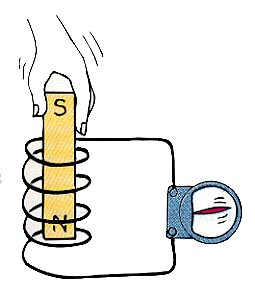 |
 |
• |
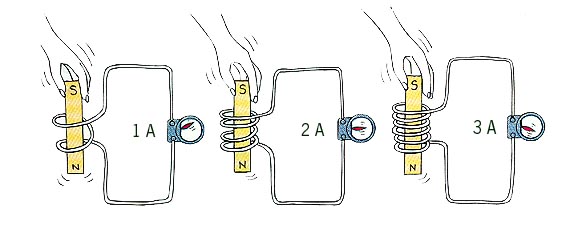 |
 |
• |
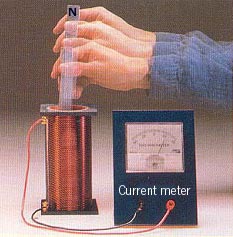 |
 |
• |
The larger the current the stronger the magnetic field. |
 |
• |
Properities of magnets |
 |
Force of attraction between like and repulsion between unlike poles. |
 |
(Opposites attract.) |
 |
Force field: Magnetic field area around magnet. |
 |
Aligned domains cause a magnet to work properly. |
 |
Permanent Magnetics |
 |
Nickle (Ni) , Iron (Fe) , Coblat (Co), Aluminium (Al) |
 |
MIxture of all above is an alloy called alnico |
 |
Demagnetification occurs if heated or dropped. Because domains get knocked out of alignment |
 |
Devices |
 |
loudspeakers |
 |
microwaves |
 |
electric clocks |
 |
motor |
 |
stereos |
 |
TV (television) |
PhySci Chapter 20 MAGNETISM
20-1 The Nature of Magnets
Magnetism: A property of matter in which there is a force of attraction or repulsion between like or unlike poles.
Magnetic Poles: The ends of magnets where the magnetic forces are strongest.
Magnetic poles always occur in pairs - North and South poles.
Magnetic forces decrease as the distance increases between the magnets.
Magnetic Field: The area around a magnet where the magnetic forces act.
A Magnetic field, represented by lines of force extending from one pole of a magnet to another, is an area over which the magnetic force is exerted.
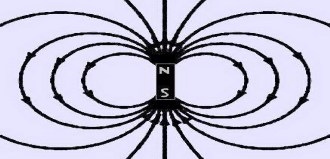
Electrons spinning around atoms create magnetic fields.
Paired electrons create magnetic fields that cancel each other.
Unpaired electrons allow atoms to act like very small magnets.
Groups of atoms that align their magnetic poles in the same direction are called Magnetic Domains.
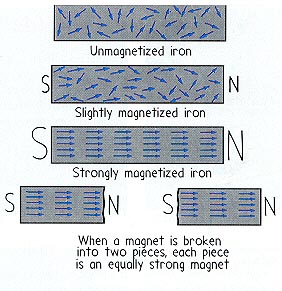
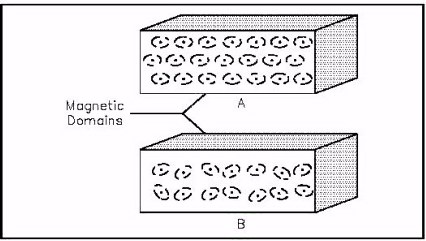
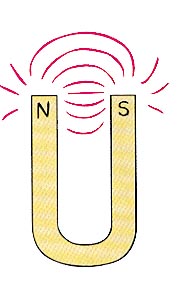
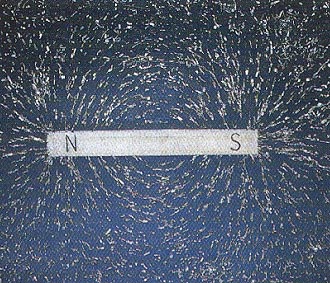
Because of the alignment, each piece of magnet, no matter how small, has a "North" and a "South
20-2 The Earth as a Magnet
The Earth behaves like it has a huge bar magnet in it and it is surrounded by a magnetic field that is strongest near the North and South Poles.
The Earth's magnetic poles reverse each half million years or so - this is recorded in the geologic rock record of the Earth.
The Sun is also a source of magnetism. It's magnetic field reverses itself about every 11 years.
20-3 Magnetism in Action
The Earth's magnetosphere deflects much of the solar wind because charged particles moving at angles to a magnetic field will tend to spiral around magnetic field lines. This, in part, accounts for the auroras at the Earth's northern and southern regions.
Physical Science Chapter 21 Electromagnetism
21-1 Magnetism from Electricity
Current passing through a wire creates a magnetic field.
Oersted discovered that an electric current flowing through a wire causes a magnetic field whose direction (where the north and south poles are) depends on the direction of current.
Solenoid: A long coil of wire that acts as a magnet when a current passes through it.
Electromagnet: A temporary magnet created by passing a current through a coil of wire. (A solenoid with an iron core.)
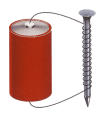

A magnetic field will exert a force on a wire carrying a current.
Electric Motor: A device that changes electrical energy into mechanical energy in order to do work.
Galvanometer: An instrument that detects electric current. (p540) It can also detect the direction of current flow.
Ammeter: Contains a galvanometer
Measures the current passing through a circuit in amperes. (Connected in "series")
Voltmeter: Contains a galvanometer Measures the "potential difference" of a circuit in volts. (Connected in "parallel")
Commutator: A reversing switch on a generator that rotates with the electromagnet - changing the direction of the current.
21-2 Electricity from Magnetism
Electromagnetic Induction: Moving a wire through a magnetic field produces a current in the wire.
Faraday discovered that a steady magnetic field did not produce an electric current. However, a changing magnetic field did "induce" a current.
(This is called electromagnetic induction.)
Generator: Produces an electric current by rotating a loop of wire in a magnetic field.
Direct Current ( DC ): Electrons flow only in one direction through a wire - "negative" terminal to "positive."
Alternating Current ( AC ): Electron flow reverses direction in a regular pattern. In the United States, household current is AC with electron flow reversing 60 times a second.
(60 cycles per second or 60 Hertz (Hz).)
Transformer: Increases or decreases the voltage of AC. The process involves both "electromagnetism" and "electromagnetic induction."













